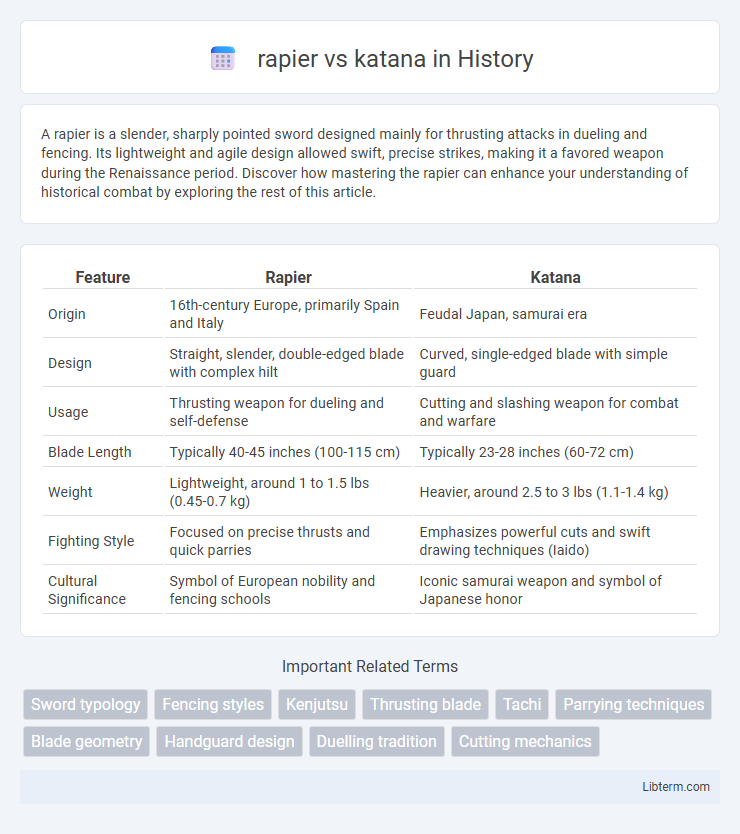A rapier is a slender, sharply pointed sword designed mainly for thrusting attacks in dueling and fencing. Its lightweight and agile design allowed swift, precise strikes, making it a favored weapon during the Renaissance period. Discover how mastering the rapier can enhance your understanding of historical combat by exploring the rest of this article.
Table of Comparison
| Feature | Rapier | Katana |
|---|---|---|
| Origin | 16th-century Europe, primarily Spain and Italy | Feudal Japan, samurai era |
| Design | Straight, slender, double-edged blade with complex hilt | Curved, single-edged blade with simple guard |
| Usage | Thrusting weapon for dueling and self-defense | Cutting and slashing weapon for combat and warfare |
| Blade Length | Typically 40-45 inches (100-115 cm) | Typically 23-28 inches (60-72 cm) |
| Weight | Lightweight, around 1 to 1.5 lbs (0.45-0.7 kg) | Heavier, around 2.5 to 3 lbs (1.1-1.4 kg) |
| Fighting Style | Focused on precise thrusts and quick parries | Emphasizes powerful cuts and swift drawing techniques (Iaido) |
| Cultural Significance | Symbol of European nobility and fencing schools | Iconic samurai weapon and symbol of Japanese honor |
Introduction to Rapier and Katana
The rapier, a slender, sharply pointed sword, was primarily used in Western Europe during the Renaissance for thrusting attacks and dueling, showcasing agility and precision. The katana, a curved, single-edged Japanese sword known for its cutting power and craftsmanship, served as the samurai's weapon, optimized for swift, decisive strikes. Both weapons reflect distinct cultural martial traditions and combat styles, emphasizing different tactical approaches and blade designs.
Historical Origins and Evolution
The rapier originated in 16th-century Europe, particularly in Italy and Spain, evolving as a slender, thrust-focused sword used primarily for civilian self-defense and dueling. The katana developed in feudal Japan during the Kamakura period (12th to 14th century) as a curved, single-edged blade designed for the samurai class, optimized for both cutting and slashing in combat. Both weapons reflect their distinct cultural and martial traditions, with the rapier emphasizing precision and reach, while the katana combines cutting efficiency with ceremonial significance.
Design and Construction Differences
The rapier features a slender, sharply pointed blade designed primarily for thrusting and intricate fencing techniques, often constructed with a complex hilt offering hand protection and agility. In contrast, the katana has a curved, single-edged blade optimized for cutting and slashing, crafted using traditional Japanese folding methods that enhance flexibility and sharpness. The rapier's lightweight steel and guard structures emphasize precision and speed, while the katana's robust tang and layered steel construction provide durability and powerful slicing capabilities.
Blade Geometry and Materials
The rapier features a slender, sharply pointed blade designed for thrusting, often crafted from high-carbon steel with a focus on flexibility and precision. The katana, characterized by its curved, single-edged blade, uses tamahagane steel folded repeatedly to create a balance of hardness and resilience, optimized for slicing. Blade geometry in the rapier emphasizes narrow width and rigidity for penetration, while the katana's curvature enhances cutting efficiency and shock absorption.
Handling and Weight Comparison
The rapier typically weighs between 2 to 3 pounds, offering exceptional balance and agility for precise thrusting maneuvers, while the katana generally ranges from 2.2 to 3.6 pounds, designed for fluid cutting and slashing motions with a slightly forward center of gravity. Rapier handles feature long, slender grips with complex swept hilts that provide superior hand protection and fine control during swift, intricate fencing techniques. Katana handles are wrapped in ray skin and cord, delivering a firm grip optimized for powerful, sweeping strikes and smooth draw techniques integral to traditional Japanese swordsmanship.
Combat Techniques and Tactics
The rapier excels in thrusting attacks due to its slender, lightweight design, enabling quick, precise strikes and effective use of complex footwork to control distance in duels. In contrast, the katana emphasizes powerful, sweeping cuts combined with rapid motion, often integrating fluid, continuous movements derived from Kenjutsu to overwhelm opponents. Tactical engagement with a rapier prioritizes finesse, timing, and counterattacks, while katana combat focuses on aggressive offense and exploiting openings through dynamic, decisive strikes.
Defensive Capabilities
The rapier features a long, slender blade designed for precise thrusting and agile parrying, making it highly effective in close-quarters defensive maneuvers. Its intricate guard offers extensive hand protection, allowing fencers to block and deflect attacks effectively. In contrast, the katana's curved, single-edged blade excels in swift cutting and slashing, with a focus on fluid defensive movements rather than rigid blocking, relying heavily on evasion and counter-striking.
Cultural Significance and Symbolism
The rapier, emblematic of European Renaissance nobility, symbolizes precision, honor, and social status within Western dueling culture. The katana, deeply rooted in Japanese samurai tradition, represents discipline, spiritual strength, and the warrior's code of Bushido. Both swords transcend their function as weapons, embodying the cultural identities and philosophical ideals of their respective societies.
Effectiveness in Duels and Warfare
The rapier excels in duels due to its lightweight design, exceptional reach, and precision thrusting capabilities, allowing for quick, agile movements and pinpoint strikes. In contrast, the katana offers superior cutting power and durability in warfare, optimized for slashing through armor and multiple opponents in close-quarters combat. While the rapier is ideal for urban duels emphasizing speed and technique, the katana's robust construction and versatility make it highly effective on the chaotic battlefield.
Modern Relevance and Legacy
The katana remains a symbol of Japanese craftsmanship and martial tradition, influencing modern sword-making and popular culture worldwide. The rapier, renowned for its precision and agility, shapes contemporary fencing techniques and historical European martial arts (HEMA) communities. Both swords continue to inspire modern combat sports, film, and collector markets, preserving their legacies through practical use and cultural reverence.
rapier Infographic

 libterm.com
libterm.com